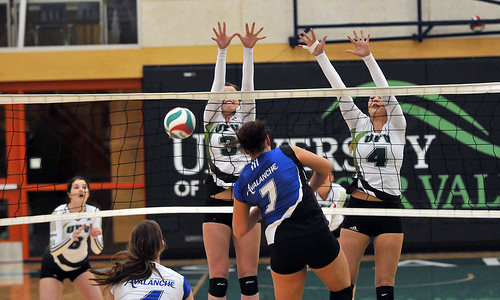- You are here:
- Home »
- Blog »
- Volleyball »
- 5 Awesome Volleyball Jumping Drills
5 Awesome Volleyball Jumping Drills
 Photo By: University of the Fraser Valley
Photo By: University of the Fraser Valley
Volleyball jumping drills are a great way to increase vertical jump ability and overall power output for athletes. Using this drills the right way will build better, more explosive athletes.
Plyometrics are the recommended types of jumps, because they are just so effective. They have been proven in numerous studies, such as this one, to provide substantial benefits in jump ability and power output. They work so well because, not surprisingly, jump training helps jumping ability. The exercises below are all very specific to volleyball players, compared to all the other potential exercises that are out there.
Before getting into any specific jumps, make sure the athletes have good overall strength and muscular development throughout their body. Plyometrics are very challenging and are too taxing for many young athletes. Always have a proper warm-up, be supervised by an experienced coach, use proper technique, and keep the reps low to focus on power.
Here are 5 awesome volleyball jumping drills:
1. Jump Squats –
As the name implies, you simply get into a squatting position and jump. This is really the basic vertical jumping movement for any sport. To improve at it, you add resistance when the athlete is ready. Start with light dumbbells, one in each arm. Eventually, you can progress into heavier dumbbells and maybe even a barbell on the back for very experienced athletes.
2. Lunge Jumps –
These are also exactly what you would expect from the name. The athlete gets into a deep lunging position, and then jumps explosively up and lands back in the lunging position, but this time with the other leg forward. While you won’t likely have to jump from a lunging position in volleyball often, this drill is one of the best ways to train single leg jumping ability. It requires tremendous power to get out of the lunging position and be able to switch legs. This is a more advanced exercise than jump squats and should only be done by strong and experienced athletes. A little resistance can go a long way here.
3. Box Jumps –
Box jumps are one of the most common and proven plyometrics. You simply jump up onto a box. If you don’t have a box available, you can use a sturdy bench or get creative finding a usable piece of equipment. Just make sure it is safe to land on top off and not too high. To increase difficulty, you can use a higher box.
4. Lateral Box Jumps –
In volleyball, you won’t always be jumping from the same angle. You will often be attacking the ball from the sides rather than straight on. Because of this, it is important to practice your jumps and develop power from different angles. The lateral box jumps can help accomplish this, because they consist of jumping sideways. Start with a very easy box height, because this is a very unnatural exercise for many athletes.
5. Rim/Net Jumps –
The video below demonstrates rim jumps for basketball, but you can get the idea to how they could be net jumps for volleyball. These are just repeat jumps aiming for a height. If the net is too short for the athlete, they can focus on a point on the wall that is out of reach. A common mistake is doing too many reps and working endurance. You should limit the total number of reps and focus on maximum height with each rep.
Remember to introduce all of these exercises slowly and conservatively. You shouldn’t even get into plyometrics until a good base level of strength is established. They should also be monitored by a qualified and experienced professional who understands how they fit into the overall training program.
Also, because volleyball players get some many jumps in over the course of practice, they don’t need a crazy amount of volume to make improvements. A few high intensity reps at the start of a training session, only after a solid warm-up, is the best way to introduce them. You want quality reps, not quantity.
Using these jumping drills won’t just improve the vertical jump of the players, but also make them better overall athletes. They will be faster and more explosive in all of their movements, which will greatly help all of their abilities on the volleyball court.

